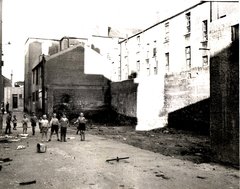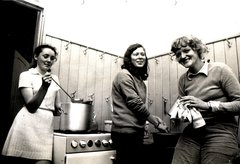Colm Dunne
England
I lived in Hatfield, Herts, England up to July 1969 when I returned to Ireland. While in England I joined IVS in St Albans and did the usual activities of painting, decorating for the old and poor families. One of our projects was organising a canal day drip on the narrow boats for handicapped children.
Merrion Square
On returning to Dublin I joined VSI in Merrion Square and met some wonderful dedicated people who were committed to alleviating some of the social issues of the time. I would like to state at this point that what I am writing is in no way an ego trip, as VSI allowed me to grow and develop in ways that no other organisation allowed and was one of the most formative experiences of my life. So when I express ideas that seem like ego tripping they were the formative experiences as unfolded within VSI for me.
At the time of joining our main activity was the painting and decorating for families and old around the city. Before a project could be undertaken, it had to be estimated and then a sponsor sought, usually Dublin Corporation Housing Dept with whom we had a good working relationship. Around this time I was project coordinator and began to see the restrictive short fall of this arrangement. As it could take up to six weeks before a project would start. After much discussion within the Group we decided to do our own fund raising for the projects. A sponsored walk was organised to Howth in which Cearbhaill O'Dailaigh, at the time Chief Justice, and later President of Ireland walked. We raised 700 pounds, a great sum in 1970. This was followed by ongoing fundraising. It allowed us to buy wallpaper in bulk from a then manufacturer in Kildare for 10p a roll. Also at the time Dulux were going metric and gave us 400 gallons of paint in imperial size for gratis. We were then free to run our own projects.
Around this time I became Chairman and noticed people of talent were joining and leaving quickly, before they could be utilised, because of the group size (it was at saturation point to which a group can grow and function) also the premises were too small.
Following discussion within the group, covering the points above. A realisation began to dawn, that the group could not expand under existing conditions. While we were doing good work, we were only providing a fire brigade service, which, while it helped individual families it did little to change the social condition in society and we needed to devise a strategy which took this into consideration. Following further discussion within the group, a strategy was decided where we needed to concentrate in areas of social need, where over a period of time we could influence the policy makers in Statutory bodies like Dublin Corporation. The tactics were to set up groups in these areas. The areas decided upon were Mountjoy Sq. and Benburb St, both areas of contained concentrated areas of social need.
Mountjoy Square
Following this, I left the Group with a number of people and with the help of the Vincent de Paul, who gave us rooms I set up a new group in Mountjoy Sq and we concentrated our work in Sean McDermott St, which was a "ghetto" of social problems. The work there involved running play schools, decorating as well as working with local groups in the area. I stayed there as Chairman for about 8 weeks and left appointing a new Chairman and committee.
Benburb St

site for Benburb St. playground
I then moved to Benburb St and set up a new group there with myself as Chairman. Benburb St was tenement housing complex of approx 188 families who were housed there for rent arrears from other Corporation housing areas. The facilities were 1 toilet and 1 handbasin on each of the landings to serve 6 families. At the time we were planning international summer work camps. I devised a 9 week programme, each of 3 weeks duration for the area. Those participating (about 20 different people for each project) were located in a disused school in Nr King St, where we slept on the floors and lived there as a community for each of the camps. I took 9 weeks unpaid leave from my job in the ESB where I was a Draughtsman and coordinated and led the projects. Much preparation work had been done in the area with the people there prior to the projects.
We organised three projects each lasting 3 weeks :

Volunteers from Ireland, Denmark and Sweden at the Benburb St projects.
1. Building a playground, for which we had to do our own fundraising and buy the equipment.
2. A Children's Camp, were we had educational activities in the morning and field trips away in the afternoon, i.e. to a farm, etc.
3. Decorating the dwellings of the people, with a precondition that they also helped in the project.
Another dimension for the playground project was the use of juvenile offenders to work with the volunteers and do it as restorative work to the community. On the children's camp we had a Garda from the local station. This was seen as necessary due to the bad relationship and misunderstanding that existed on both sides.
Dept of Justice
In order for this to happen I had meetings in the Dept of Justice and with the Garda authorities and they readily agreed. The overall final result was beneficial to all.
The work camps achieved their goals with positive results for the community. I devised the budget for the 9 weeks which included buying the playground equipment etc, we fundraised and sought sponsorship as well. The budget was achieved to within 10 pounds of the target estimate of £1331.
Follow-up to Work Camps
The follow up was aided by a local business man Mr Lemass, who gave us a disused house in need of repair. We spent many months, as a group, living at weekends in the house doing the necessary repair work. This included having the roof retiled, etc. The house was opened as a community centre. We had budgeting classes, sewing classes and also free legal aid. There were children's groups, but the big success was the disco which we ran weekly. This usually involved standing at the door with a pickaxe handle as things were rough. The biggest weapon we had was "barring" and it worked.
The most successful project involved rent arrears and negotiations with the Corporation. The scheme worked with a number of families. Usually all their money was spent by Monday and they had none for the rent. Myself and another person would go there on Friday night with a cheque made payable to the Corporation (which would include the rent due and a certain of the arrears) and exchange the cheque for money. After some of the arrears were paid off, we would negotiate with the Corporation and have the family re-housed in proper conditions. This worked and gave them hope.
During this time we coordinated the local and statutory organisation to form a council to devise a cohesive plan for the area. A survey was conducted of the conditions of the Benburb St and the families. We held a press conference and published the results without naming the area or families. This resulted in much public awareness to the extent that the residents of Benburb St organised protests and as a result the Corporation closedBenburb St and rehoused all the families in other areas. The playground we built, we deconstructed it and relocated it to the children's hospital in Cappagh.
Northern Ireland
Around this time there was the "troubles" in the North. The philosophy on which VSI was founded was adopted from the parent international organisation SCI. We felt, if we failed to respond to the situation in the North, then we would have failed the ideals under which SCI was founded. Myself and Margaret Duffy attended the International meeting of SCI in Switzerland and spoke of the need to be involved in the North. Following this we formed a committee with our sister organisations in the North IVS and Britain and organised children's camps away from the North to Europe and the UK and here. The first year of operation saw 600 children of both communities being sent at a cost of £19,000 , much being raised by public appeal through Helen Honeyman of IVS. To further our work, we employed a full time worker Sean Armstrong to work with both communities in Belfast. Sean was later murdered for his work by a paramilitary organisation.
Expansion
VSI was an expanding organisation and in need of a Constitution to cater for this. Many weekends were spent by many people to make this happen and I had the privilege of being its 1st president on the adoption of the Constitution. My involvement ended around 1974/5 but the few years I spent there were the most formative and developmental of all my life. I had developed talent and skills that I later applied to Scouting and other areas of my life as it led me to become a Probation Officer. For many people VSI changed their life for the better in order to serve society. To mention but one, Alice Leahy and her work with the homeless. Also Bro. Kevin, with whom we worked at the time.
Colm Dunne